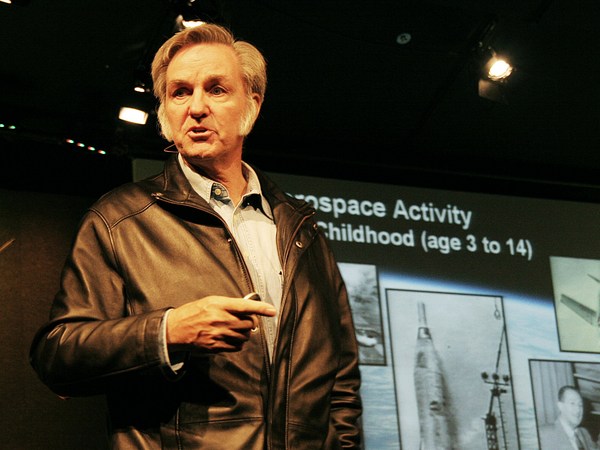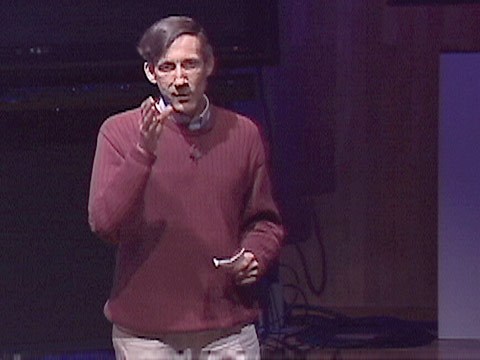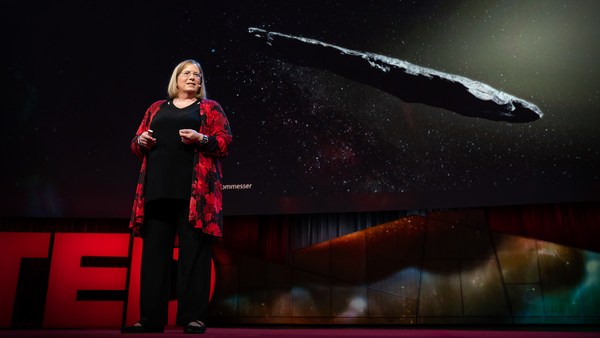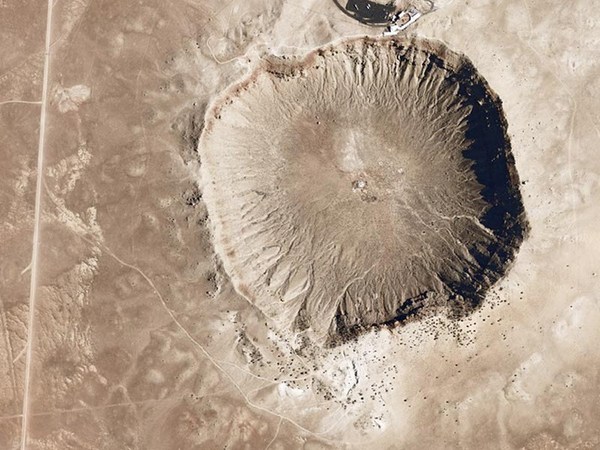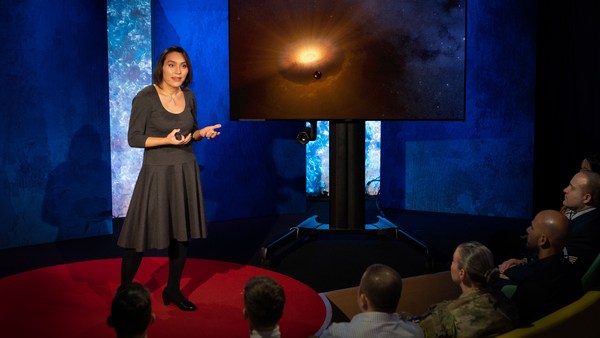I'd like to take you on the epic quest of the Rosetta spacecraft. To escort and land the probe on a comet, this has been my passion for the past two years. In order to do that, I need to explain to you something about the origin of the solar system.
When we go back four and a half billion years, there was a cloud of gas and dust. In the center of this cloud, our sun formed and ignited. Along with that, what we now know as planets, comets and asteroids formed. What then happened, according to theory, is that when the Earth had cooled down a bit after its formation, comets massively impacted the Earth and delivered water to Earth. They probably also delivered complex organic material to Earth, and that may have bootstrapped the emergence of life. You can compare this to having to solve a 250-piece puzzle and not a 2,000-piece puzzle.
Afterwards, the big planets like Jupiter and Saturn, they were not in their place where they are now, and they interacted gravitationally, and they swept the whole interior of the solar system clean, and what we now know as comets ended up in something called the Kuiper Belt, which is a belt of objects beyond the orbit of Neptune. And sometimes these objects run into each other, and they gravitationally deflect, and then the gravity of Jupiter pulls them back into the solar system. And they then become the comets as we see them in the sky.
The important thing here to note is that in the meantime, the four and a half billion years, these comets have been sitting on the outside of the solar system, and haven't changed -- deep, frozen versions of our solar system.
In the sky, they look like this. We know them for their tails. There are actually two tails. One is a dust tail, which is blown away by the solar wind. The other one is an ion tail, which is charged particles, and they follow the magnetic field in the solar system. There's the coma, and then there is the nucleus, which here is too small to see, and you have to remember that in the case of Rosetta, the spacecraft is in that center pixel. We are only 20, 30, 40 kilometers away from the comet.
So what's important to remember? Comets contain the original material from which our solar system was formed, so they're ideal to study the components that were present at the time when Earth, and life, started. Comets are also suspected of having brought the elements which may have bootstrapped life. In 1983, ESA set up its long-term Horizon 2000 program, which contained one cornerstone, which would be a mission to a comet. In parallel, a small mission to a comet, what you see here, Giotto, was launched, and in 1986, flew by the comet of Halley with an armada of other spacecraft. From the results of that mission, it became immediately clear that comets were ideal bodies to study to understand our solar system. And thus, the Rosetta mission was approved in 1993, and originally it was supposed to be launched in 2003, but a problem arose with an Ariane rocket. However, our P.R. department, in its enthusiasm, had already made 1,000 Delft Blue plates with the name of the wrong comets. So I've never had to buy any china since. That's the positive part. (Laughter)
Once the whole problem was solved, we left Earth in 2004 to the newly selected comet, Churyumov-Gerasimenko. This comet had to be specially selected because A, you have to be able to get to it, and B, it shouldn't have been in the solar system too long. This particular comet has been in the solar system since 1959. That's the first time when it was deflected by Jupiter, and it got close enough to the sun to start changing. So it's a very fresh comet.
Rosetta made a few historic firsts. It's the first satellite to orbit a comet, and to escort it throughout its whole tour through the solar system -- closest approach to the sun, as we will see in August, and then away again to the exterior. It's the first ever landing on a comet. We actually orbit the comet using something which is not normally done with spacecraft. Normally, you look at the sky and you know where you point and where you are. In this case, that's not enough. We navigated by looking at landmarks on the comet. We recognized features -- boulders, craters -- and that's how we know where we are respective to the comet.
And, of course, it's the first satellite to go beyond the orbit of Jupiter on solar cells. Now, this sounds more heroic than it actually is, because the technology to use radio isotope thermal generators wasn't available in Europe at that time, so there was no choice. But these solar arrays are big. This is one wing, and these are not specially selected small people. They're just like you and me. (Laughter) We have two of these wings, 65 square meters. Now later on, of course, when we got to the comet, you find out that 65 square meters of sail close to a body which is outgassing is not always a very handy choice.
Now, how did we get to the comet? Because we had to go there for the Rosetta scientific objectives very far away -- four times the distance of the Earth to the sun -- and also at a much higher velocity than we could achieve with fuel, because we'd have to take six times as much fuel as the whole spacecraft weighed. So what do you do? You use gravitational flybys, slingshots, where you pass by a planet at very low altitude, a few thousand kilometers, and then you get the velocity of that planet around the sun for free. We did that a few times. We did Earth, we did Mars, we did twice Earth again, and we also flew by two asteroids, Lutetia and Steins. Then in 2011, we got so far from the sun that if the spacecraft got into trouble, we couldn't actually save the spacecraft anymore, so we went into hibernation. Everything was switched off except for one clock. Here you see in white the trajectory, and the way this works. You see that from the circle where we started, the white line, actually you get more and more and more elliptical, and then finally we approached the comet in May 2014, and we had to start doing the rendezvous maneuvers.
On the way there, we flew by Earth and we took a few pictures to test our cameras. This is the moon rising over Earth, and this is what we now call a selfie, which at that time, by the way, that word didn't exist. (Laughter) It's at Mars. It was taken by the CIVA camera. That's one of the cameras on the lander, and it just looks under the solar arrays, and you see the planet Mars and the solar array in the distance.
Now, when we got out of hibernation in January 2014, we started arriving at a distance of two million kilometers from the comet in May. However, the velocity the spacecraft had was much too fast. We were going 2,800 kilometers an hour faster than the comet, so we had to brake. We had to do eight maneuvers, and you see here, some of them were really big. We had to brake the first one by a few hundred kilometers per hour, and actually, the duration of that was seven hours, and it used 218 kilos of fuel, and those were seven nerve-wracking hours, because in 2007, there was a leak in the system of the propulsion of Rosetta, and we had to close off a branch, so the system was actually operating at a pressure which it was never designed or qualified for.
Then we got in the vicinity of the comet, and these were the first pictures we saw. The true comet rotation period is 12 and a half hours, so this is accelerated, but you will understand that our flight dynamics engineers thought, this is not going to be an easy thing to land on. We had hoped for some kind of spud-like thing where you could easily land. But we had one hope: maybe it was smooth. No. That didn't work either. (Laughter)
So at that point in time, it was clearly unavoidable: we had to map this body in all the detail you could get, because we had to find an area which is 500 meters in diameter and flat. Why 500 meters? That's the error we have on landing the probe. So we went through this process, and we mapped the comet. We used a technique called photoclinometry. You use shadows thrown by the sun. What you see here is a rock sitting on the surface of the comet, and the sun shines from above. From the shadow, we, with our brain, can immediately determine roughly what the shape of that rock is. You can program that in a computer, you then cover the whole comet, and you can map the comet. For that, we flew special trajectories starting in August. First, a triangle of 100 kilometers on a side at 100 kilometers' distance, and we repeated the whole thing at 50 kilometers. At that time, we had seen the comet at all kinds of angles, and we could use this technique to map the whole thing.
Now, this led to a selection of landing sites. This whole process we had to do, to go from the mapping of the comet to actually finding the final landing site, was 60 days. We didn't have more. To give you an idea, the average Mars mission takes hundreds of scientists for years to meet about where shall we go? We had 60 days, and that was it.
We finally selected the final landing site and the commands were prepared for Rosetta to launch Philae. The way this works is that Rosetta has to be at the right point in space, and aiming towards the comet, because the lander is passive. The lander is then pushed out and moves towards the comet. Rosetta had to turn around to get its cameras to actually look at Philae while it was departing and to be able to communicate with it.
Now, the landing duration of the whole trajectory was seven hours. Now do a simple calculation: if the velocity of Rosetta is off by one centimeter per second, seven hours is 25,000 seconds. That means 252 meters wrong on the comet. So we had to know the velocity of Rosetta much better than one centimeter per second, and its location in space better than 100 meters at 500 million kilometers from Earth. That's no mean feat.
Let me quickly take you through some of the science and the instruments. I won't bore you with all the details of all the instruments, but it's got everything. We can sniff gas, we can measure dust particles, the shape of them, the composition, there are magnetometers, everything. This is one of the results from an instrument which measures gas density at the position of Rosetta, so it's gas which has left the comet. The bottom graph is September of last year. There is a long-term variation, which in itself is not surprising, but you see the sharp peaks. This is a comet day. You can see the effect of the sun on the evaporation of gas and the fact that the comet is rotating. So there is one spot, apparently, where there is a lot of stuff coming from, it gets heated in the Sun, and then cools down on the back side. And we can see the density variations of this.
These are the gases and the organic compounds that we already have measured. You will see it's an impressive list, and there is much, much, much more to come, because there are more measurements. Actually, there is a conference going on in Houston at the moment where many of these results are presented.
Also, we measured dust particles. Now, for you, this will not look very impressive, but the scientists were thrilled when they saw this. Two dust particles: the right one they call Boris, and they shot it with tantalum in order to be able to analyze it. Now, we found sodium and magnesium. What this tells you is this is the concentration of these two materials at the time the solar system was formed, so we learned things about which materials were there when the planet was made.
Of course, one of the important elements is the imaging. This is one of the cameras of Rosetta, the OSIRIS camera, and this actually was the cover of Science magazine on January 23 of this year. Nobody had expected this body to look like this. Boulders, rocks -- if anything, it looks more like the Half Dome in Yosemite than anything else. We also saw things like this: dunes, and what look to be, on the righthand side, wind-blown shadows. Now we know these from Mars, but this comet doesn't have an atmosphere, so it's a bit difficult to create a wind-blown shadow. It may be local outgassing, stuff which goes up and comes back. We don't know, so there is a lot to investigate. Here, you see the same image twice. On the left-hand side, you see in the middle a pit. On the right-hand side, if you carefully look, there are three jets coming out of the bottom of that pit. So this is the activity of the comet. Apparently, at the bottom of these pits is where the active regions are, and where the material evaporates into space. There is a very intriguing crack in the neck of the comet. You see it on the right-hand side. It's a kilometer long, and it's two and a half meters wide. Some people suggest that actually, when we get close to the sun, the comet may split in two, and then we'll have to choose, which comet do we go for? The lander -- again, lots of instruments, mostly comparable except for the things which hammer in the ground and drill, etc. But much the same as Rosetta, and that is because you want to compare what you find in space with what you find on the comet. These are called ground truth measurements.
These are the landing descent images that were taken by the OSIRIS camera. You see the lander getting further and further away from Rosetta. On the top right, you see an image taken at 60 meters by the lander, 60 meters above the surface of the comet. The boulder there is some 10 meters. So this is one of the last images we took before we landed on the comet. Here, you see the whole sequence again, but from a different perspective, and you see three blown-ups from the bottom-left to the middle of the lander traveling over the surface of the comet. Then, at the top, there is a before and an after image of the landing. The only problem with the after image is, there is no lander. But if you carefully look at the right-hand side of this image, we saw the lander still there, but it had bounced. It had departed again.
Now, on a bit of a comical note here is that originally Rosetta was designed to have a lander which would bounce. That was discarded because it was way too expensive. Now, we forgot, but the lander knew. (Laughter) During the first bounce, in the magnetometers, you see here the data from them, from the three axes, x, y and z. Halfway through, you see a red line. At that red line, there is a change. What happened, apparently, is during the first bounce, somewhere, we hit the edge of a crater with one of the legs of the lander, and the rotation velocity of the lander changed. So we've been rather lucky that we are where we are.
This is one of the iconic images of Rosetta. It's a man-made object, a leg of the lander, standing on a comet. This, for me, is one of the very best images of space science I have ever seen.
(Applause)
One of the things we still have to do is to actually find the lander. The blue area here is where we know it must be. We haven't been able to find it yet, but the search is continuing, as are our efforts to start getting the lander to work again. We listen every day, and we hope that between now and somewhere in April, the lander will wake up again.
The findings of what we found on the comet: This thing would float in water. It's half the density of water. So it looks like a very big rock, but it's not. The activity increase we saw in June, July, August last year was a four-fold activity increase. By the time we will be at the sun, there will be 100 kilos a second leaving this comet: gas, dust, whatever. That's 100 million kilos a day.
Then, finally, the landing day. I will never forget -- absolute madness, 250 TV crews in Germany. The BBC was interviewing me, and another TV crew who was following me all day were filming me being interviewed, and it went on like that for the whole day. The Discovery Channel crew actually caught me when leaving the control room, and they asked the right question, and man, I got into tears, and I still feel this. For a month and a half, I couldn't think about landing day without crying, and I still have the emotion in me.
With this image of the comet, I would like to leave you.
Thank you.
(Applause)
